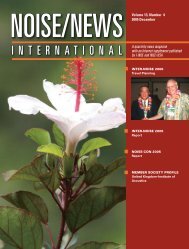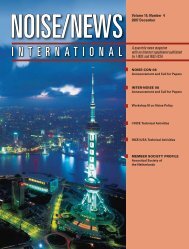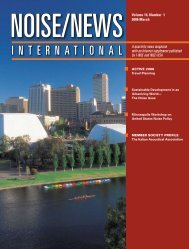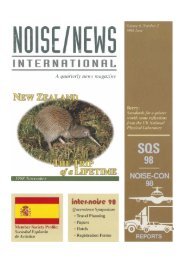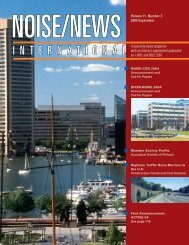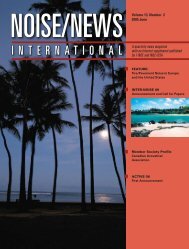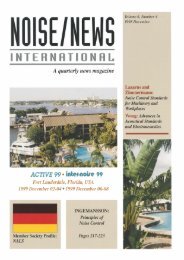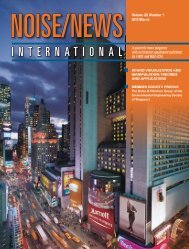Volume 3, Number 4, December, 1995 - Noise News International
Volume 3, Number 4, December, 1995 - Noise News International
Volume 3, Number 4, December, 1995 - Noise News International
Create successful ePaper yourself
Turn your PDF publications into a flip-book with our unique Google optimized e-Paper software.
develop a new proposal for the definition of thisadjustment. This working group is expected toevaluatethe intensive researchon thissubjectwhichhas been performed during the last decade 20 - 23 .In addition to the adjustments, there are alsodifferences in the reference time intervals and thedecisive time periods within the reference time intervals.In somecountries, theday issubdividedintotwo referencetime intervals whichallows for separateassessments of the exposureduringthe day andat night. Othercountriespreferthree referencetimeintervals- day, rest periods, and night. Usingthreereference time intervals, the rest periods can beprotected more efficiently. Twenty-four hour levelsare not found in the countriesconsidered.In most countries, the exposureis notdeterminedfor the whole reference time interval but only forthe most disadvantageous hours within it. Thenumber of hours that have to be considered variesfrom 1 h to 16h during the daytimeand from 0.5 hto 12 h at night.Thus, the protectionof the populationcan be considerably improved for intermittentnoise.In mostcountries, the rating procedure is carriedout by comparing the noise index (primarily therating level) with immission values. These valuesarepresented inTable I .It showsthat thedifferencesbetween immission values for daytimeand rest periodstypicallyamount to 5 dB. The values for daytimeand nighttime typically differ by 10 dB. Butdifferences of 15dB are also in use.Insomeprovinces ofCanada,thelevel of the roadtraffic noise is taken as a yardstick for industrialnoise. In Great Britain, the rating level of the industrialnoise must not surpass the background L 90 bymore than IO dB. This type of regulation, whichspecifies that the difference between the level ofindustrial noise and the level of the backgroundnoise must not exceed a certain amount, has beenintroduced in France and Italy as an additional criterionfor the assessment of industrial noise whichmust be verified separately. (In France, the differenceshould be less than 3 dB, in Italy, less than 5dB).A comparison between the immission values invarious countries shows that differences can be upto 15dBbetweencountries. But becauseof differentdegrees of enforcement of the regulations(limiting,guideline, planning, recommended values) and differencesin procedures mentioned above, thisnumberhas to be interpreted cautiously.Therequirements fornoise fromindustrial installationsare in generally good agreement with thedraft guideline values of the WHO for desirable oracceptable environmental conditions...



